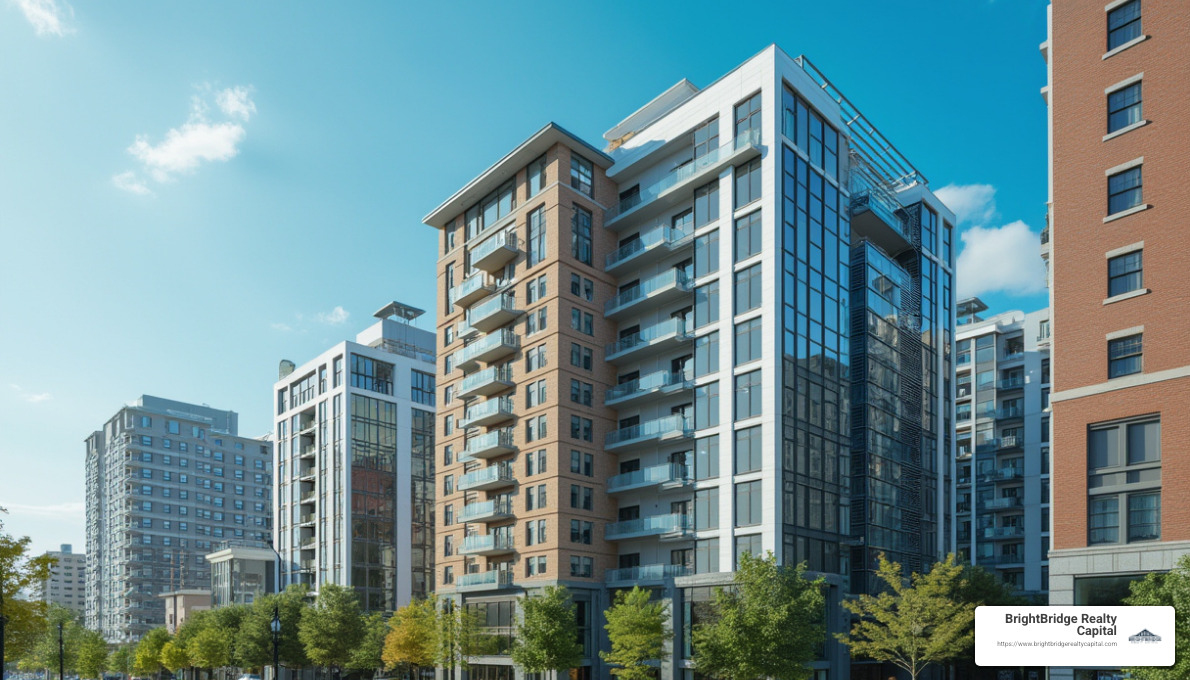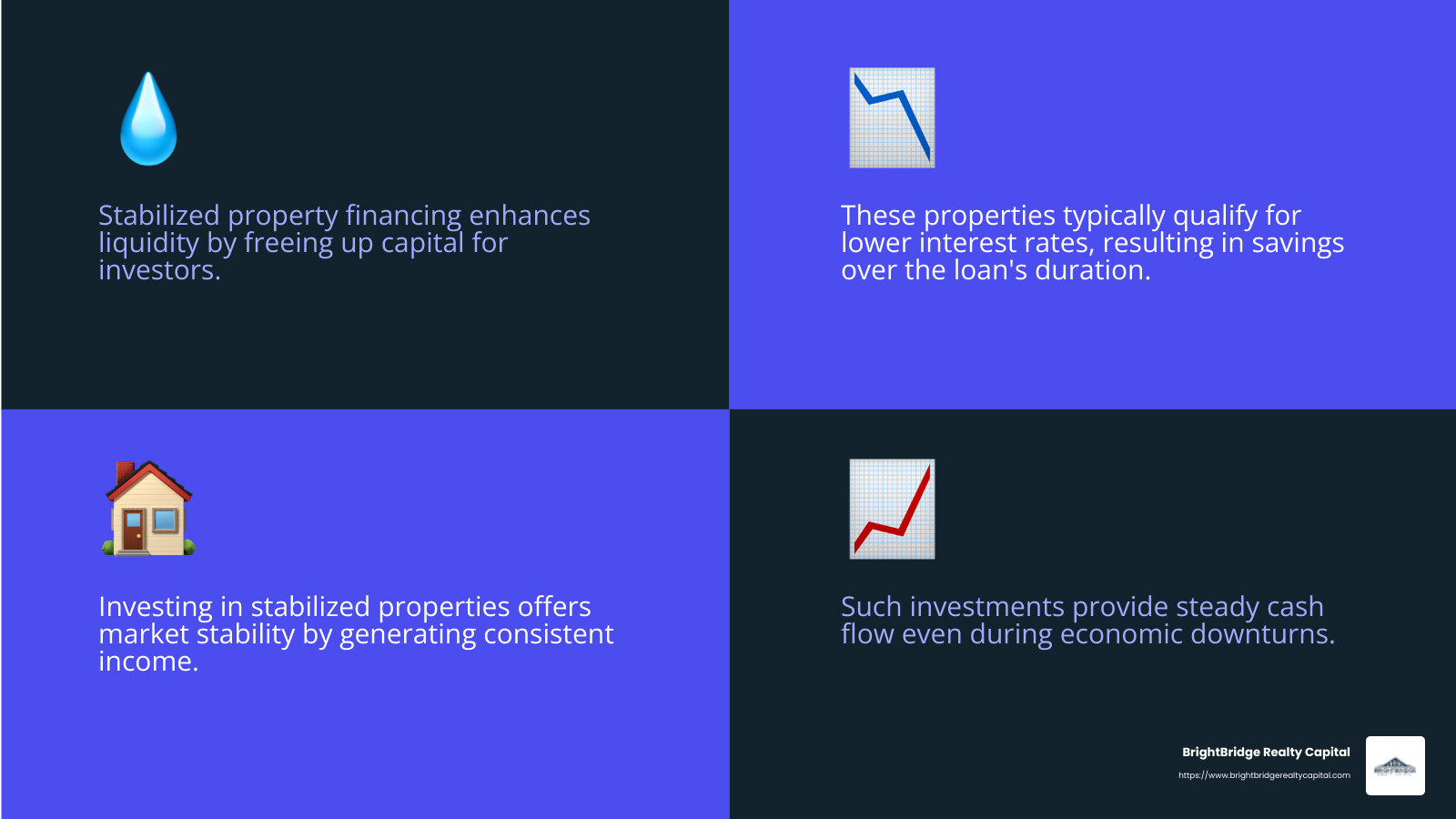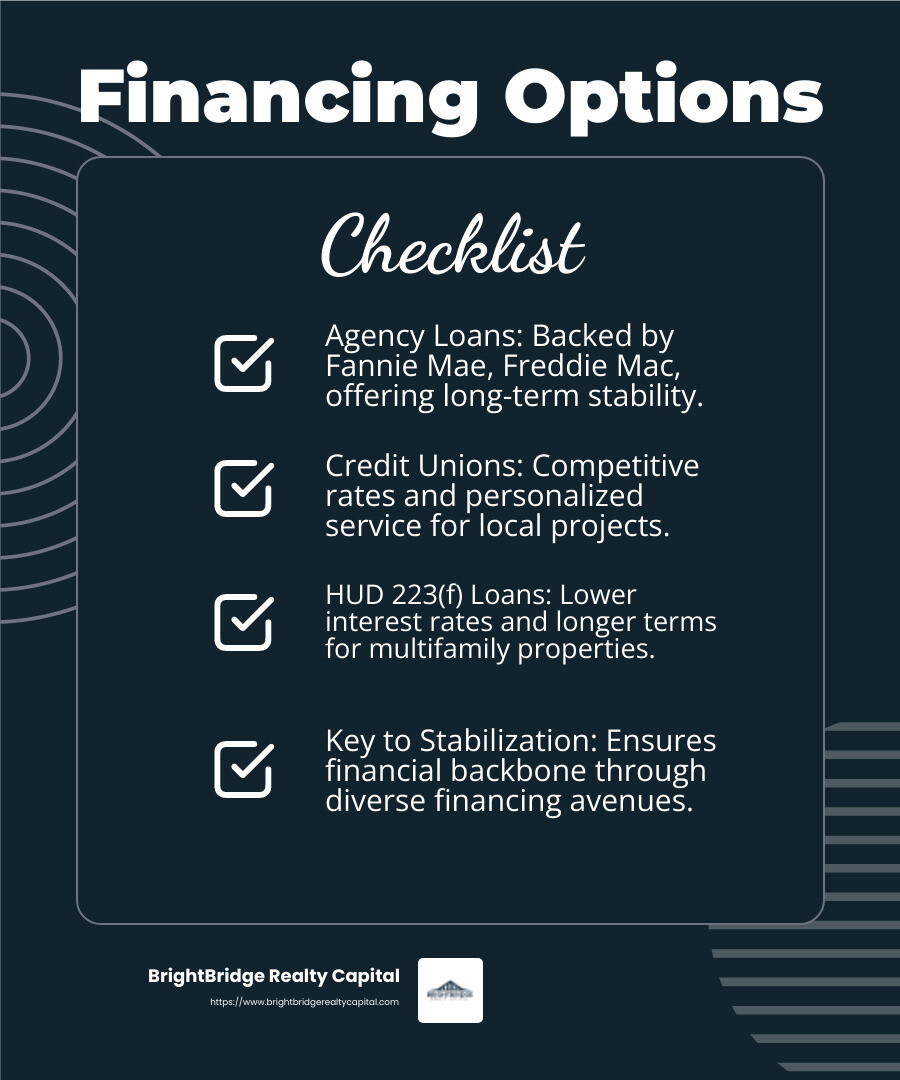Stabilized Success: Your Guide to Property Financing

Stabilized property financing is a key tool for real estate investors seeking to maximize returns and ensure steady financial growth. This type of financing is all about achieving a consistent level of property occupancy and, eventually, positioning a rental property as a reliable income generator. When an investor achieves property stabilization, they are not only securing their real estate investment but also open uping potential access to favorable financing terms.
Key Points on Stabilized Property Financing:
- Stabilization refers to maintaining a steady occupancy level needed for income to exceed expenses.
- Financing solutions for stabilized properties can improve investment potential.
- Achieving stabilized occupancy is crucial for leveraging permanent mortgage options.
With the right financing solutions, investors can secure stable, long-term success in the commercial real estate market. By understanding the ins and outs of stabilized property financing, investors can better weather economic downturns and capitalize on lucrative opportunities.

Understanding Stabilized Property Financing
Benefits of Stabilized Property Financing
Stabilized property financing offers several advantages for investors looking to improve their real estate portfolios. One of the primary benefits is liquidity. By securing a permanent mortgage loan on an income-producing property, investors can free up capital for other ventures. This means more opportunities for growth without the need to sell assets.
Another significant advantage is interest rates. Stabilized properties typically qualify for more favorable interest rates compared to properties in the development or renovation stages. This can lead to substantial savings over the life of the loan, making the investment more profitable.
Moreover, investing in stabilized properties provides a level of market stability. These properties are already generating income, which can buffer against market fluctuations. As a result, investors can enjoy a steady cash flow, even during economic downturns.

Risks and Challenges
Despite the benefits, there are also risks associated with stabilized property financing. One of the main challenges is construction costs. If a property requires renovations to achieve stabilization, costs can escalate quickly. This can impact the overall return on investment.
Another risk is the outcome of renovations. Even with significant improvements, there's no guarantee that renovations will attract the desired tenants or achieve the expected rental rates. This uncertainty can affect the property's ability to generate income.
Market conditions also play a crucial role. Economic downturns or changes in local real estate markets can influence property values and occupancy rates. Investors must be prepared to steer these challenges to ensure their investments remain profitable.
In summary, while stabilized property financing offers liquidity, favorable interest rates, and market stability, weigh these benefits against potential risks such as rising construction costs and market volatility. Understanding these factors can help investors make informed decisions and achieve long-term success.
Types of Loans for Stabilized Properties
When it comes to financing stabilized properties, investors have several loan options to consider. Each type of loan offers unique benefits and caters to different investment strategies. Here, we explore bridge loans, agency loans, and short-term interest-only loans.
Bridge Loans
Bridge loans are a popular choice for investors seeking short-term financing. These loans provide immediate cash flow, allowing investors to seize opportunities quickly. They are ideal for those who need to secure a property while waiting for permanent financing or the sale of another property.
Bridge loans are typically characterized by:
- Short terms: Usually ranging from 12 to 36 months.
- Flexibility: No prepayment penalties, allowing investors to pay off the loan early without extra costs.
- Higher interest rates: Reflecting the convenience and speed of access to funds.
These loans are particularly useful for investors who need to act fast in competitive markets or when transitioning between properties.
Agency Loans
For more stable, long-term financing, agency loans are an excellent option. These loans are backed by government-sponsored enterprises like Fannie Mae, Freddie Mac, and the HUD 223(f) program. They offer several advantages:
- Competitive interest rates: Favorable rates due to government backing.
- Longer terms: Options ranging from 5 to 30 years, providing stability and predictability.
- Non-recourse: Protecting personal assets in case of default, with exceptions for "bad acts" like fraud.
Agency loans are suitable for investors with properties that have achieved a level of stabilization and are generating consistent income. They are an excellent choice for multifamily properties, offering terms that align with long-term investment goals.
Short-Term Interest-Only Loans
Short-term interest-only loans are another financing option for stabilized properties. These loans allow investors to pay only the interest for a set period, typically 1 to 3 years. This can improve cash flow, enabling investors to reinvest in other projects or improve the property further.
Key features include:
- Interest-only payments: Lower monthly payments initially, freeing up cash for other uses.
- Flexibility: Terms can be customized to fit specific investment goals.
- Fast approval: Streamlined application processes, often with pre-approval within 24 hours.
These loans are ideal for investors looking to maximize cash flow in the short term while planning to refinance or sell the property in the near future.
By understanding the different types of loans available for stabilized properties, investors can choose the best financing option for their specific needs and investment strategies. Whether seeking short-term flexibility or long-term stability, there is a loan product designed to support their goals.
The Role of "As Stabilized Value" in Financing
In real estate financing, the "as stabilized value" plays a crucial role. This value represents the estimated worth of a property once it achieves optimal occupancy and income levels. Understanding this concept is essential for investors, as it impacts property valuation, income generation, and loan eligibility.
Determining As Stabilized Value
The as stabilized value is like a crystal ball for investors and lenders. It helps them see the future financial potential of a property. This value is not just a guess; it's calculated by professional appraisers or valuation experts who consider several factors:
- Current and projected market rents: What are similar properties charging for rent? What can this property charge once stabilized?
- Occupancy rates: How many units or spaces are expected to be occupied?
- Operating expenses: What will it cost to run the property once improvements are made?
These experts use an income capitalization approach to estimate the property's future income. Essentially, they look at how much money the property can generate and apply a formula to determine its value.
The Importance of Accurate Valuation
Accurate valuation is critical. Lenders often base their loan amounts on the as stabilized value, expecting that the property will reach this level of performance. If a property is undervalued, it might not get enough financing. Overvaluation, on the other hand, can lead to financial strain if the property doesn't perform as expected.
Appraisers and valuation experts play a pivotal role here. They bring their expertise in analyzing market trends and property specifics to provide a reliable forecast. Their assessments guide both investors and lenders, ensuring that everyone understands the financial landscape.
By focusing on the as stabilized value, investors can make informed decisions about financing and development strategies. This value serves as a roadmap, showing the potential income-generating capacity of a property and helping to secure the necessary funding to achieve those goals.
In the next section, we'll explore the steps to achieve property stabilization, diving into how occupancy, market research, and financing options come together to transform potential into reality.
Steps to Achieve Property Stabilization
Achieving property stabilization is like putting together a puzzle. You need the right pieces: occupancy, market research, and financing. Let's break down each component to see how they fit together.
Occupancy
Occupancy is the heartbeat of property stabilization. It's about getting units filled with reliable tenants. High occupancy rates mean steady rental income, which is crucial for a property's financial health.
To boost occupancy, consider these strategies:
- Market Analysis: Understand the local rental market. What do tenants want? What are the going rents? This helps you price your units competitively.
- Property Improvements: Sometimes, a little renovation can make a big difference. Updated amenities or fresh paint can attract more tenants.
- Effective Marketing: Use online platforms and local advertising to reach potential renters. Highlight what makes your property special.
Market Research
Market research is your guide to making smart decisions. It gives you insight into trends and demands in your area. Here's how to use it effectively:
- Local Data: Gather information on rental rates, vacancy rates, and tenant preferences. This helps you set competitive prices and identify opportunities for growth.
- Demographic Trends: Who's moving into the area? Young professionals, families, or retirees? Tailor your property to meet their needs.
Financing Options
Financing is the backbone of property stabilization. Without the right funds, achieving stabilization can be a challenge. Fortunately, there are several options available:
Agency Loans: These loans, backed by Fannie Mae, Freddie Mac, or HUD, offer favorable terms for multifamily properties. They are ideal for long-term financing and provide stability.
Credit Unions: Local credit unions can be a valuable resource. They often offer competitive rates and personalized service, making them a great option for community-focused projects.
HUD Programs: HUD 223(f) loans are specifically designed for refinancing or acquiring multifamily properties. They offer lower interest rates and longer terms, which can be beneficial for properties undergoing stabilization.

Each financing option has its own set of requirements and benefits. It's crucial to evaluate which one aligns best with your property's needs and your long-term goals.
By focusing on occupancy, conducting thorough market research, and exploring various financing options, investors can set the stage for successful property stabilization. These steps lay the groundwork for changing a property into a reliable income-generating asset.
In the next section, we'll dive deeper into the frequently asked questions about stabilized property financing, addressing common concerns and providing clarity on this complex process.
Frequently Asked Questions about Stabilized Property Financing
What is property stabilization?
Property stabilization is when a rental property achieves a steady state of operation. It's about reaching a level of occupancy where the property generates enough income to cover its expenses, or even better, make a profit. Think of it as the "sweet spot" where everything runs smoothly.
For example, imagine a new apartment building that just opened. Initially, it might have low occupancy because it's new to the market. Over time, as it attracts tenants and fills up, it reaches stabilized occupancy. This is the point where the property is reliably generating income, making it attractive for long-term financing options like HUD 223(f) loans.
How does property stabilization benefit investors?
Property stabilization offers several benefits to investors:
Predictable Income: Once stabilized, a property provides a steady stream of rental income, which is essential for covering costs and generating profits.
Increased Liquidity: A stabilized property is often easier to finance or refinance. Lenders see it as less risky, which can open up more financing options and potentially lower interest rates.
Market Stability: Stabilized properties contribute to the overall stability of the real estate market. When properties are full and generating income, it reflects positively on market conditions.
For instance, in Section 8 housing, the Department of Housing and Urban Development (HUD) covers the difference between the subsidized rental rate and what a resident can pay. This ensures that even if a tenant loses their job, the rent gets paid, offering investors a safety net.
What are the eligibility criteria for HUD 223(f) loans?
HUD 223(f) loans are a popular choice for financing stabilized multifamily properties. To qualify, a property must meet certain criteria:
Stabilized Occupancy: The property should have had stabilized occupancy for at least three years. This means it should consistently generate enough income to cover its expenses.
Property Condition: The property must be in good condition, with no major repairs needed. It should be ready to support tenants without extensive renovations.
Loan Amount: The loan size can vary, but it generally needs to meet minimum thresholds set by HUD.
Debt Service Coverage Ratio (DSCR): A minimum DSCR is required, usually around 1.25x, ensuring the property generates sufficient income to cover its debt obligations.
These loans provide long-term, non-recourse financing, making them an attractive option for properties that have achieved stabilization. They offer lower interest rates and longer terms, which can be beneficial for maintaining financial stability.
Understanding these FAQs about stabilized property financing can help investors make informed decisions. Armed with the right knowledge, you can steer the complexities of property financing with confidence.
In the next section, we'll explore the conclusion of our guide, highlighting how BrightBridge Realty Capital can provide customized solutions and fast closings for your property financing needs.
Conclusion
At BrightBridge Realty Capital, we understand that every real estate investor has unique needs. That's why we offer customized solutions custom to your specific goals. Whether you're flipping properties, building from the ground up, or expanding your rental portfolio, our expert team is here to help you every step of the way.
One of the standout features of our service is our ability to offer fast closings. In the world of real estate, timing is everything. We pride ourselves on our quick, seamless process that often sees deals closed within a week. This speed allows you to seize opportunities as they arise without the typical delays associated with traditional financing.
As a direct lender, we cut out the middleman to offer competitive rates and a hassle-free experience. Our nationwide reach ensures you have access to the capital you need, no matter where your investment properties are located. With our extensive network of over 150 lenders, we provide the financial flexibility and support you need to achieve your investment goals.
For more information on how we can assist you with stabilized property financing, explore our loan options at BrightBridge Realty Capital. Let us be your trusted partner in navigating the complex world of real estate financing.


